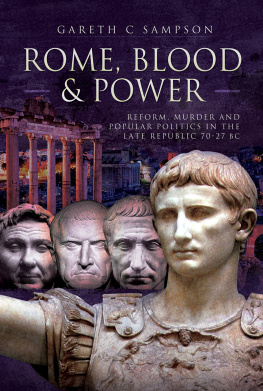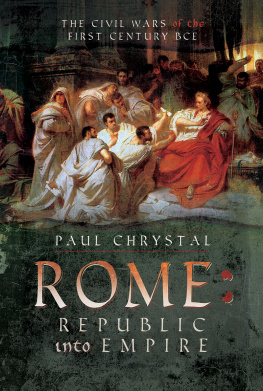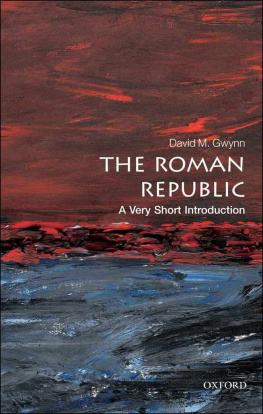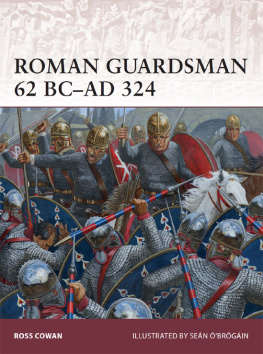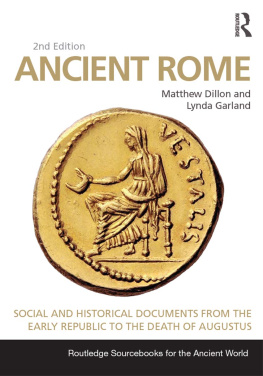Clan Fabius, Defenders of Rome
For Olivia
Clan Fabius, Defenders of Rome
A History of the Republics Most Illustrious Family
Jeremiah McCall
First published in Great Britain in 2018
by Pen & Sword History
An imprint of Pen & Sword Books Limited
47 Church Street
Barnsley
South Yorkshire
S70 2AS
Copyright Jeremiah McCall 2018
ISBN 978 1 47388 561 5
eISBN 978 1 47388 563 9
Mobi ISBN 978 1 47388 562 2
The right of Jeremiah McCall to be identified as
Author of this Work has been asserted by him in accordance
with the Copyright, Designs and Patents Act 1988.
A CIP catalogue record for this book is
available from the British Library
All rights reserved. No part of this book may be reproduced or transmitted in any form or by any means, electronic or mechanical including photocopying, recording or by any information storage and retrieval system, without permission from the Publisher in writing.
Pen & Sword Books Limited incorporates the imprints of Atlas,
Archaeology, Aviation, Discovery, Family History, Fiction, History,
Maritime, Military, Military Classics, Politics, Select, Transport,
True Crime, Air World, Frontline Publishing, Leo Cooper,
Remember When, Seaforth Publishing, The Praetorian Press,
Wharncliffe Local History, Wharncliffe Transport,
Wharncliffe True Crime and White Owl.
For a complete list of Pen & Sword titles please contact
PEN & SWORD BOOKS LIMITED
47 Church Street, Barnsley, South Yorkshire, S70 2AS, England
E-mail:
Website: www.pen-and-sword.co.uk
Contents
Chapter 1
Introduction
For centuries after the event, the Romans told tales of a noble clan, the Fabii, whose men sacrificed their lives for the good of the Republic. At their own expense and from their own family, they would muster a warband, build a fort on the far side of the Cremera River and punish the Veientes for their crimes. The tales differ at this point: either the Fabii alone, some 300 men, built the fort that was to be a thorn in Veiis side, or they brought along their loyal retainers and clients, some 4,000, to assist. But the effect was clear. The Fabii watched the frontiers and took their own vengeance on Veii, raiding its lands and plundering its herds. For some time, the Roman border with Veii was quiet, well protected by Fabian arms.
Ancient Italy.
And then, disaster. The Veientes baited a trap, leaving some prime flocks ostensibly untended while gathering their forces just out of sight. The Fabii, bold from their many successful raids, approached the flocks without scouting the surrounding environs: a mistake. Veientine warriors burst out of hiding and surrounded the valiant Fabii. Herders no more, now the Fabii were themselves herded into a cramped space. Though they fought mightily, the tale-tellers told, they died where they stood, overwhelmed. Three hundred and six Fabii died that day, all the men in the family. The Fabian clan would have been extinguished forever, except that one youth, named Marcus, escaped the massacre. He became the progenitor of what would eventually become the Fabius Maximus clan, the father of a family of heroes who would serve the Republic well indeed over the centuries.
These tales of the three brothers and the disaster at the Cremera mark the first discoverable appearance of that famous Fabian clan in the history of the Roman Republic. To understand that tale and consider what historical reality may be behind it, however, requires some background in the early history of the Romans. According to the accounts later Romans wrote, the city was founded on some hills south of the Tiber less than 20 miles from the sea by the legendary king Romulus in the middle of the eighth century BC. Six subsequent kings ruled the nascent state, tradition told, each contributing important religious, political, military and legal customs and institutions. As Rome developed internally, it also grew in power and prestige in the region of central Italy called Latium. After a couple of centuries under beneficent masters, however, the Romans came to be ruled by a malevolent Etruscan king, Tarquinius Superbus, Tarquin the Proud. His oppressive rule, and his sons rape of the virtuous Lucretia, wife of an influential young man, pushed the Roman aristocracy past the breaking point, and, in the late sixth century, those aristocrats eradicated the monarchy and replaced it with a new form of government, the Republic. The name itself in Latin is res publica and means public affairs or public matters.
Historians have frequently challenged the details of this ancient narrative. The basic picture that the city of Rome began as a monarchy is plausible enough, as is the creation of a Republic. It seems clear, however, that the Republican form of government did not simply spring fully formed from the murdered monarchy. Rather, its offices and their powers and interactions, the rules of politics, developed slowly over the centuries. Still, since the historical Fabii were, first and foremost, aristocrats of the Roman Republic, it is worth briefly examining the basic components of that Republic.
The Workings of the Roman Republic
Polybius is the starting point for those investigating the classical Republic of the second century BC.
Polybius, who wrote in Greek for an audience not wholly familiar with Roman customs, suggests three political organs shared power in the Roman Republic. The consuls were the chief magistrates. Elected in pairs that held office for one year only, the consuls were the chief executives and military commanders. They held by right of their office imperium , a term that translates roughly as power. That power included the right to levy and command armies and have ones commands obeyed. Though Polybius does not mention them in his basic account, there were other magistrates in the Roman government: among others, praetors who served as judges and, by the middle Republic, governors of territories under Roman control, aediles, who maintained the temples and held public games, and censors, who were responsible for managing the lists of citizens and their corresponding military obligations.
The second critical government body was the Senate. Until perhaps 300 BC, the Senate was little more than a group of distinguished elders selected first by the kings and later by the chief magistrates to provide counsel. The informality of membership in the Senate meant the body of senators fluctuated from year to year. Under these circumstances, the Senate did not fully function as a regular governing body. Over time, however, the custom developed that it might be a more permanent body consisting of lifelong members. This custom was put into law, perhaps, by the lex Ovinia of the later fourth century BC. So unlike today, where senators in the United States are elected officials, senators in the Republic were those whom the censors deemed the best men. In practice, this meant those who had held political office. From this time on, those Romans honoured with senatorial status retained that status for life, so long as they conducted themselves appropriately and were not struck from the list of senators by a disapproving censor. This shift dramatically enhanced the prestige of senatorial status. By Polybius day the Senate wielded a great deal of informal, but very real, power. It was the body that assigned provinces of action to the military commanders of the year, consuls and, sometimes, praetors. It received the growing number of foreign envoys and conducted diplomacy. Most importantly of all, perhaps, the Senate effectively controlled the state funds and their use. As convention had it, the Senate also deliberated issues before putting proposals before the citizen assemblies for a vote.



